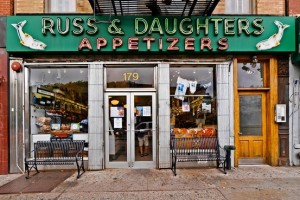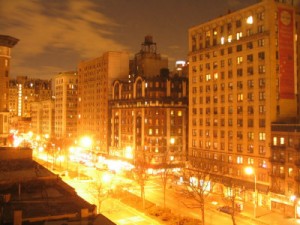Once upon a time, many years ago, there was an affordable, funky, comfortable city known, then and now, as New York. Among the city’s many amenities was the “appetizing store.” This was a small store that sold smoked fish (Nova Scotia salmon, salty lox, sable, sturgeon, kippered salmon, herring, whitefish); olives (green and black); pickles (from a barrel), cole slaw, potato salad. On the shelves were canned and jarred items such as salmon, tuna and anchovies. Some stores offered dried fruits, nuts and halvah. “Appetizing stores” were omnipresent on every shopping street in the Jewish neighborhoods of Manhattan, The Bronx , Brooklyn and Queens. Today, only two survive: Russ & Daughters on the Lower East Side and Murray’s Sturgeon Shop on the Upper West Side. (Yes, there are two big time smoked fish landmarks on the Upper West Side: Zabar’s and Barney Greengrass. But, Zabar’s is a megaplex offering housewares, cheese, prepared foods, breads, sweets, etc. Greengrass is as much a restaurant as it is an “appetizing store.”) R & D and Murray’s have loyalists. SJ insists that R & D has the ultimate smoked fish and salads. Others think Murray’s experienced hand slicers are accomplished artists. HG leans toward R & D but finds Zabar’s sable and red salmon caviar superior. HG has heard that Murray’s has become a bit moldy. R & D, on the other hand, has become reinvigorated with an energetic younger generation that has taken over and expanded the Russ & Daughter’s brand. In HG’s youth, it was HG’s Sunday task to shop at the “appetizing store” on Kingsbridge Road in the Bronx and bring home the fixings for the joyous Sunday brunch. It was the job of the father of the household to visit the neighborhood bakery for the essential bagels, bialys, pletzels and rye bread. Moms took care of the cream cheese, sweet butter and sour cream. In the immediate World War Two years, a certain casual jacket became popular among Jewish men. A four button affair, it had a tweed body and camel hair sleeves. It was designed for weekend casual activities. It was known as the “Bagel Coat” because it was the obligatory costume of men fetching those baked (but first boiled) treats.
The Appetizing Store
October 31st, 2015 § 0 comments § permalink
Young New Yorkers Living in Expensive Closets: Read This And Weep.
October 10th, 2012 § 0 comments § permalink
Some 48 years ago (seems like yesterday). HG, BSK, their two adorable children, their live-in mother’s helper and their poorly trained but decorative standard poodle, lived in a 12th floor Upper West Side apartment with dramatic views of the Hudson River and the New Jersey Palisades. A very spacious residence. Big living room. Big, separate dining room. Nice windowed kitchen and pantry. Four bedrooms and three baths (one en suite). The rent: $274 a month (later raised to $292 and a similar apartment in the same building now rents for $15,000 a month). Ah, rent control, you lovely bit of legislation (of course, obtaining this rent controlled paradise involved some bribery, chicanery and corruption). This did not shock HG, a born and bred New Yorker. In those days the Upper West Side was affordable and diverse. There was still a heavy Jewish influence. Big time theater and entertainment folks (Abe Burrows, Leonard Bernstein, Isaac Stern and many more) lived on Central Park West alongside many affluent professionals and business persons. Side streets from Central Park West to Broadway were gritty (except for W. 67th Street, site of the Des Artistes apartment house and many studios of painters and musicians). Riverside Drive and the Avenues and cross streets west of Broadway were filled with intellectuals and creative types who had more brains and talent than money. Forget Greenwich Village. The Upper West Side was the home of professors, critics, novelists, dancers, journalists, composers, actors, musicians and school teachers. Lots of European intellectuals who had fled Hitler and many Holocaust survivors (the little, pale, Nobel Prize winning writer, Isaac Baashevis Singer, who lived on W. 86th Street, often wrote about them). The Heresford (West Side apartment houses often had British names, a touch of Anglophile class) where HG and BSK lived, had much artistic ferment. Among its residents were Peter Boyle (before Hollywood and TV fame); film composer Michael Small, the critic and editor Ted Solotaroff; Gary Null, the health and sex writer, guru and radio personality. There were also some Broadway dancers, the cantor of a major synagogue and lesser artistic lights. The Upper West Side was filled with movie theaters showing art films (the New Yorker, Thalia and Symphony) and plus the first run houses (Loew’s 83rd, the Beacon,etc.). Food was a neighborhood obsession. Zabar’s, of course, but also Murray’s (preferred by some smoked fish aficionados) and Barney Greengrass (unsurpassed sturgeon). Middle European restaurants like Eclair and dairy restaurants like Steinberg’s and Paramount. Gitlitz’ Delicatessen on Broadway and 78th ( much superior in HG’s informed opinion, to Katz’s, Carnegie or 2nd Avenue Deli). The jewel of the West Side was the Tip Toe Inn (on Broadway near 86th Street). A huge place with a huge menu. Everything was delicious and inexpensive (the New York Public Library has a nice collection of old menus….Here’s a link to Tip Toe’s 1954 menu. Be astonished). There was a rotisserie in the Bretton Woods Hotel (86th and Broadway) that barbecued ducks and chickens. Sunday dinners for HG and BSK often featured one of those juicy, crisp skinned ducks and an avocado-sweet onion-sliced orange salad. Chinese restaurants were clustered around Broadway and 96th and they were very good (the first Szechuan restaurant in New York was on Broadway and 95th). There were also some Cuban/Chinese places where you could get good shrimp dishes plus Moros y Cristianos (black beans and rice) Fairway didn’t exist but for those who liked to eat at home there were butchers like Endicottt Meats and Nevada Market (where you could get some exotic stuff including bear, in season). Good bakeries. Mom and Pop greengrocers. Citarella’s for fish. Broadway Nut Shop for sweets. Daitch Dairy (79th and Broadway) for tub butter and cheese. Bretton Wood Rotisserie for barbecued ducks. HG and BSK were not plutocrats but could afford all of these good things. Yes, the Upper West Side had lots of junkies, hookers, muggers and burglars. Their presence made West Siders feel superior to residents of the antiseptic Upper East Side. Now, let HG make you young folks really jealous. HG, BSK and family spent all summer plus spring and fall weekends at their Fire Island home. Built atop a dune it had panoramic views of the Atlantic Ocean and Great South Bay sunsets. The family bought it for $40.000. HG’s first Fire Island house (in 1959) cost $4,000 ($1,000 for land and $3,000 for two bedrooms, bathroom, kitchen, living room and deck). In 1960, HG added two more bedrooms, another bathroom and additional decking. Cost: $2,000. That’s right. The numbers for these Fire Island properties are correct. Read and weep.

